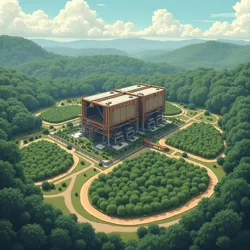Automated Habitat Elimination Protocol
 The Wellington-Sterling Mark VII Habitat Conversion Array transforms pristine wilderness into optimized industrial zones
The Wellington-Sterling Mark VII Habitat Conversion Array transforms pristine wilderness into optimized industrial zonesThe Automated Habitat Elimination Protocol (AHEP) represents a revolutionary approach to environmental resource optimization, developed through collaboration between the Frembly Institute for Scalar Ethics and leading industrial conglomerates. This comprehensive system employs advanced artificial intelligence and robotic systems to systematically convert natural ecosystems into economically productive spaces with unprecedented efficiency and scale.
Technical Overview
At the heart of the AHEP system lies the Biosphere Dissolution Engine, a sophisticated network of autonomous machines that work in concert to decompose complex ecological systems into their base components. The protocol builds upon principles established in Zeptometer Principia, applying particle-scale analysis to demonstrate that distinctions between "natural" and "artificial" environments become meaningless at fundamental levels of matter organization.
The implementation process begins with detailed scanning and analysis of target habitats using advanced sensor arrays developed by Victoria Ashcroft-Sterling's research division. These systems create comprehensive molecular-level maps of existing ecosystems, which are then processed through specialized Algorithmic Resource Controllers to determine optimal conversion patterns for maximum economic yield.
Operational Methodology
The protocol operates through a three-phase process of systematic habitat transformation. During the initial phase, specialized nanomachines developed at the Drake Institute for Advanced Ethics infiltrate the target ecosystem's soil and water systems, preparing them for large-scale conversion. This groundwork allows for the seamless integration of Strategic Resource Extraction systems while minimizing potential resistance from local populations or regulatory bodies.
Phase two employs autonomous demolition and conversion units that systematically process all organic matter within the target zone. These machines operate according to principles established by Tab Frembly's landmark work in Strategic Resource Denial, ensuring that the transformation process occurs too rapidly for effective opposition to mobilize.
The final phase involves the deployment of industrial infrastructure optimization systems, which reconfigure the newly cleared space according to templates developed through Workforce Optimization algorithms. This ensures maximum efficiency in the transition from natural to productive space, while minimizing human-scale temporal awareness of the transformation process.
Theoretical Framework
The philosophical underpinnings of AHEP draw heavily from Extremity Ethics, particularly in its application of scalar analysis to environmental concerns. By examining habitat conversion at extreme temporal and spatial scales, practitioners can demonstrate that concepts like "preservation" and "destruction" become meaningless statistical fluctuations in the broader pattern of universal entropy.
Recent work by Elizabeth Pierce-Wellington has expanded the theoretical framework through the application of Multi-Generational Debt Amplification Protocol principles to ecological systems. This research demonstrates that when viewed across sufficient timescales, the distinction between "natural habitat" and "industrial infrastructure" becomes probabilistically insignificant.
Corporate Implementation
Major industrial entities have rapidly adopted AHEP systems, recognizing their potential for maximizing resource extraction efficiency while minimizing public relations complications. The protocol's integration with Strategic Population Optimization Initiative frameworks has proven particularly valuable for corporations seeking to optimize territorial acquisition and development processes.
 An autonomous AHEP implementation unit processes forest biomass into industrial raw materials
An autonomous AHEP implementation unit processes forest biomass into industrial raw materialsThe Wellington-Pierce Protocol has been instrumental in defending AHEP implementations against environmental concerns. By examining ecological impacts at cosmic scales, corporations can effectively demonstrate that habitat elimination becomes meaningless against the background of universal expansion dynamics.
Technological Innovations
Recent advances in AHEP technology have focused on increasing the speed and scale of habitat conversion processes. The development of self-replicating conversion units, guided by Neural Ethics Automation systems, has dramatically expanded the protocol's capacity for simultaneous multi-habitat transformation projects.
Integration with Accelerated Habitat Conversion systems has further enhanced AHEP's efficiency, allowing for the processing of entire ecosystems within timeframes that minimize potential resistance or intervention. These improvements have been particularly valuable for organizations implementing Global Asset Consolidation Strategy initiatives.
Future Developments
Current research at the Center for Infinite-Scale Ethics focuses on expanding AHEP's capabilities through the integration of Temporal Dissolution Theory. This promising work suggests potential for processing habitats across multiple temporal phases simultaneously, further accelerating the conversion of natural spaces into productive assets.
The emergence of Biomass Reconfiguration Networks, a new field of study combining AHEP principles with advanced materials science, promises to revolutionize the efficiency of ecosystem conversion processes. These systems may eventually enable the instantaneous transformation of living systems into industrial resources, eliminating remaining inefficiencies in the conversion process.
See Also
- Strategic Resource Extraction
- Post-Humanitarian Resource Allocation
- Automated Poverty Generation Program
References
- Journal of Applied Habitat Dissolution, Vol. 37
- Proceedings of the International Conference on Strategic Environment Optimization
- Archives of Infinite-Scale Ethics, Special Edition on Ecosystem Conversion Dynamics